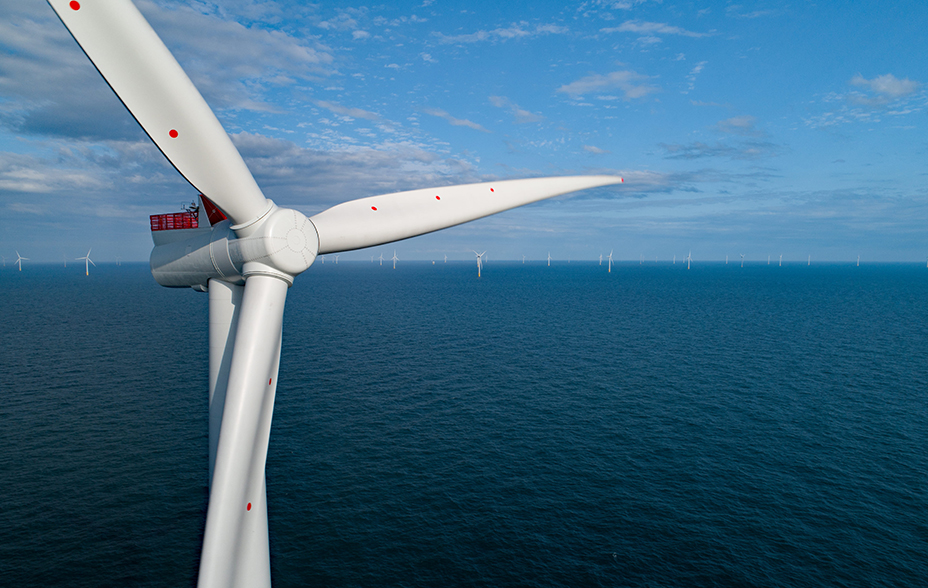
All investment strategies have the potential for profit and loss, your or your clients’ capital may be at risk.
The words ‘greenhouse gas emissions’ conjure images of melting polar ice caps, severe flooding, extreme heat waves and devastating droughts in most people’s minds. However, I recently visited a company trying to change that.
Just outside Chicago, scientists at LanzaTech are commercialising a process that converts industrial emissions into ethanol. The colourless liquid can be further refined into materials for fabrics for clothing or sustainable aviation fuel.
The chemicals specialist is helping to turn greenhouse gas emissions from waste into a valuable commodity. And its partners include ArcelorMittal, one of the world’s largest steel makers, British Airways, and Zara.
LanzaTech is just one of many companies using new technologies and innovations to solve climate change. But for now, there’s no shortage of doom-and-gloom news about the issue. And the rhetoric has led to a new trend of ‘eco-anxiety’, especially among younger people.
This can be counterproductive. While I don’t want to downplay the threats of climate change, I am also confident in human ingenuity and technological advances as drivers of progress.
As a manager for Keystone Positive Change Investment Trust and the Baillie Gifford Positive Change Fund, I am fortunate to meet passionate entrepreneurs and business people working on innovations that can help address climate change. Positive Change invests in some of those companies and will likely make more investments in the future. The remainder of this article looks at some of those businesses and innovations.
Energy and climate
The causal link between greenhouse gas (GHG) emissions and climate change is well-established. When we examine the source of GHG emissions, the vast majority comes from our energy use (73 per cent). However, if we include the emissions from agriculture (because food is another form of energy), then emissions from energy become more than 90 per cent. Hence, decarbonising our energy system is essential to addressing climate change.
Source: Our World in Data, 2016. ourworldindata.org/emissions-by-sector
Another reason to focus on energy is its centrality to human flourishing. There is a close relationship between energy consumption and economic activity. We can debate whether GDP is a useful measure of humanity’s success, but it’s clear that a flourishing society requires a large and growing amount of energy.
A flourishing society, in the sense of more sophisticated art, science and technology and emotional connections between individuals, must form part of the vision for a sustainable future. Therefore, our goal for the energy system should focus on its decarbonisation and growth.
Source: Our World in Data, based on Vaclav Smil (2017) and BP Statistical Review of World Energy. World GDP in 2011 Int.$, based on World Bank & Maddison (2017)
How do we achieve this goal? I believe there are four things we need to do:
1. Electrify as much energy use as possible – transportation, heating and others.
2. Ensure that electricity comes from renewable sources. This involves accelerating the buildout of solar, wind and other renewables and investing in the grid to handle more intermittent generation and greater electricity demand.
3. Decarbonise hard-to-abate sectors by improving efficiency, reducing waste and developing novel technologies.
4. Scale up high-quality carbon removal projects to remove historical excess CO2.
Positive Change invests in companies that are contributing to all four areas.
1. Electrification
Electricity’s share of our energy consumption has slowly increased since the Edison Electric Light Company began operating the world’s first commercial power station at 57 Holborn Viaduct in London in 1882. In 1973, electricity accounted for 9.5 per cent of the world’s final energy consumption. By 2019, this has risen to 19.7 per cent.
The slow pace of electrification thus far is a reminder that electricity has suffered from two limitations: it’s not well-suited for applications that require energy in high-density forms, and it’s less economical for processes requiring high temperatures. Thankfully, technological advances are helping to address both limitations, providing hope that electrification will accelerate in the coming decades.
Cheaper and better batteries are helping to address the first limitation, enabling the electrification of transportation. Portfolio holding Tesla is a pioneer of electric vehicles. Since launching the original Tesla Roadster, Tesla has steadily brought down the cost of electric vehicles through innovation and scale.
The pace of cost reduction underpins Tesla’s competitive advantage and is vital to improving the affordability of electric vehicles. Tesla delivered 1.3 million electric vehicles in 2022, and its long-term ambition is to produce 20 million electric vehicles per year.
Road transportation accounts for 12 per cent of global GHG emissions. If we electrify road transportation entirely and ensure the electricity comes from renewable sources, this could avoid six billion tons of carbon dioxide equivalent (CO2e) annually, which is equivalent to the annual GHG emissions of North America.
Source: Baillie Gifford research, Tesla, trailing twelve-month data.
Electrification is taking off, literally. Portfolio holding Joby Aviation is leading the development and commercialisation of a new mode of transportation, electric vertical take-off and landing (eVOTL). Joby’s aircraft has a range of up to 150 miles and a top speed of 200 miles per hour. The company is progressing with Federal Aviation Administration (FAA) certification to certify its aircraft for commercial passenger use and has partnered with Delta, ANA, and others to realise this concept.
A range of innovations is required to address electricity’s second limitation. For instance, the Australian company Calix is developing a new type of kiln that can heat minerals to 950C using electricity. Its technology could help to decarbonise industries such as lime and cement production, which thus far relied on fossil fuels for heating. Boston Metal is working on electrifying steel production with its molten oxide electrolysis technology. The firm uses electricity to heat iron ore in a cell at 1,600C, enabling it to separate oxide from iron without needing carbon.
2. Renewable generation and the grid
While coal powered Edison’s first power station in London, today, more and more electricity generation involves renewable technologies. In 2020, 80 per cent of the world’s new electricity capacity came from renewable sources, with solar and wind accounting for 91 per cent of that. Since 2010, the share of global electricity generation from solar and wind has quintupled from 2 per cent to 10 per cent. In the UK, solar and wind have gone from 3 per cent of electricity generation to 25 per cent over the same period.
Portfolio holding Ørsted is contributing to the buildout of renewable generation. The company is the world leader in offshore wind after pioneering the sector in the early 21st century. It’s also a major developer of onshore wind and solar projects, and invests in newer technologies such as green hydrogen. In 2022, Ørsted generated 30 tera-watt hours (TWh) of electricity from solar and wind, helping to avoid 18.2 million tons of CO2e or equivalent to the total annual emissions of 4.5 million cars.

As more solar and wind join the generation mix, we need to invest more in our electricity grids to overcome the challenge of intermittency. Energy storage will play an important role. Energy storage stores excess electricity and helps maintain grid stability through frequency management and synthetic inertia.
Portfolio holdings Tesla and Northvolt are two companies contributing to this area. Tesla is a leading provider of stationary energy storage systems and software, with an annual deployment of 6.5 gigawatt hours (GWh) in 2022. Northvolt is building out Europe’s battery production capacity, with an emphasis on sustainability through using renewable power and recycling.
3. Hard-to-abate sectors
Agriculture accounts for about 20 to 25 per cent of global GHG emissions. Decarbonising food production is a complex challenge that requires multiple solutions.
Portfolio holding Deere is contributing to this goal with its precision agriculture offerings. Precision agriculture leverages advancements in digital technologies to help farmers obtain higher yields while reducing pesticide and fertiliser usage. For example, Deere’s See & Spray technology uses computer vision and machine learning to identify weeds from crops in real time. Sprayers then target only the weeds, reducing herbicide usage by over two-thirds.
Construction is another tricky sector to decarbonise. Buildings account for 38 per cent of energy- and process-related GHG emissions globally. The industry is one of the slowest to digitalise. As a result, a significant proportion of projects finish late, and 10 per cent of the materials used in construction go to waste.
Portfolio holding Autodesk is changing this. The company is the leading software provider for the architecture, engineering, and construction (AEC) sector. In recent years, it has launched a range of products that are helping to improve efficiency.
For instance, Autodesk’s Embodied Carbon Calculator helps designers choose materials with lower embodied carbon. Autodesk Insight empowers architects and engineers to design more energy-efficient buildings by providing an advanced simulation of building performance. And Autodesk Construction Cloud optimises workflows for project owners and contractors to reduce the likelihood of rework.
4. Carbon removal
To maximise our chances of limiting global warming to 1.5C, the world must reduce emissions at an unprecedented speed and, in addition, remove historical and unavoidable CO2 emissions from the atmosphere. While nature-based solutions such as soil management and reforestation will play a role, there is increasing consensus that engineered solutions will complement nature-based solutions by providing high permanence and verifiable carbon removal.
Keystone portfolio holding Climeworks is a leader in direct air capture (DAC). Two mechanical engineering students from ETH Zurich founded the company in 2009, aiming to inspire one billion people to remove CO2 from the air. In 2021, the company launched Orca, the world’s largest operating DAC and storage facility, in Iceland. It partnered with companies including Microsoft, BCG, UBS and Swiss Re.

In 2022, along with other investors, Keystone Positive Change Investment Trust supported Climeworks’ CHF 600m equity raise (£534m at 1 April 2023), providing primary capital to support the company’s expansion. Climeworks is now constructing its next facility, Mammoth, which, when operational, will have an annual nominal capture capacity of up to 36,000 tons. Climeworks will not stop there. The company has an ambitious scale-up plan to capture 1 million tons of CO2 from the atmosphere by 2030, and to be on track to gigaton capacity by 2050.
Summary
Climate change is an urgent challenge that society needs to address. The task might appear daunting, but there are reasons for optimism. Technological advancements and human ingenuity will usher in solutions we can’t imagine today.
As managers of Keystone Positive Change Investment Trust and the Baillie Gifford Positive Change Fund, we will be searching for them. We will deepen our research in this area, identifying promising innovations and finding opportunities worth our shareholders’ investment. We believe that companies addressing climate change have the prospects of creating enormous societal and economic value over the coming decades.
Important information
|
2019 |
2020 |
2021 |
2022 |
2023 |
|
-3.2 |
-26.9 |
34.9 |
-10.2 |
-13.3 |
Source: Morningstar, share price, total return, sterling.
|
|
2019 |
2020 |
2021 |
2022 |
2023 |
|
Baillie Gifford Positive Change Fund |
11.0 |
15.9 |
79.3 |
2.1 |
-9.3 |
|
Benchmark – MSCI AC World |
11.1 |
-6.2 |
39.6 |
12.9 |
-0.9 |
|
Target Benchmark - MSCI AC World +2%pa |
13.3 |
-4.3 |
42.4 |
15.2 |
1.1 |
|
Sector Average - IA Global Sector |
9.0 |
-6.0 |
40.6 |
8.4 |
-2.7 |
Source: FE. Class B accumulation shares. Returns reflect the annual charges but exclude any initial charge paid.
Past performance is not a guide to future returns.
The manager believes the MSCI AC World is an appropriate benchmark given the investment policy of the Fund and the approach taken by the manager when investing. There is no guarantee that this objective will be achieved over any time period and actual investment returns may differ from this objective, particularly over shorter time periods. In addition, the manager believes an appropriate performance comparison for this Fund is the Investment Association IA Global Sector.
The Keystone Positive Change Investment Trust and the Positive Change Fund invest in companies that make a positive impact on society and/or the environment. This means the Fund and Trust won’t invest in certain sectors and companies, limiting the investments available. Therefore, returns may be different to a Fund or Trust that has no such restrictions.
The views expressed in this recording should not be considered as advice or a recommendation to buy, sell or hold a particular investment. The article contains information and opinion on investments that does not constitute independent investment research, and is therefore not subject to the protections afforded to independent research.
Some of the views expressed are not necessarily those of Baillie Gifford. Investment markets and conditions can change rapidly, therefore the views expressed should not be taken as statements of fact nor should reliance be placed on them when making investment decisions.
Baillie Gifford & Co Limited is wholly owned by Baillie Gifford & Co. Both companies are authorised and regulated by the Financial Conduct Authority and are based at: Calton Square, 1 Greenside Row, Edinburgh EH1 3AN.
The investment trusts managed by Baillie Gifford & Co Limited are listed on the London Stock Exchange and are not authorised or regulated by the Financial Conduct Authority. Baillie Gifford & Co Limited is an Authorised Corporate Director of OEICs.
A Key Information Document is available by visiting bailliegifford.com
ref: 40605 10020174






